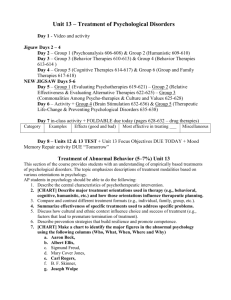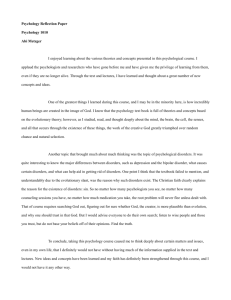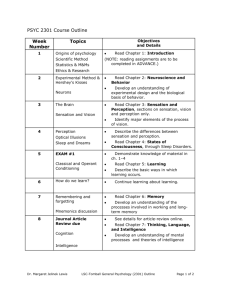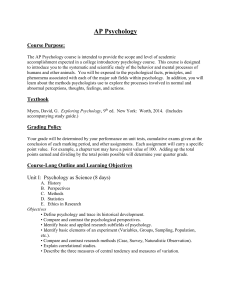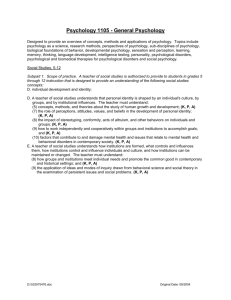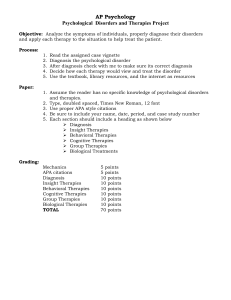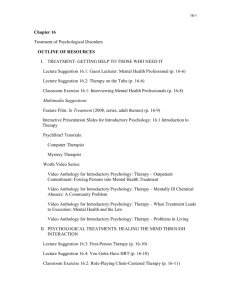AP Psychology Course Syllabus
advertisement
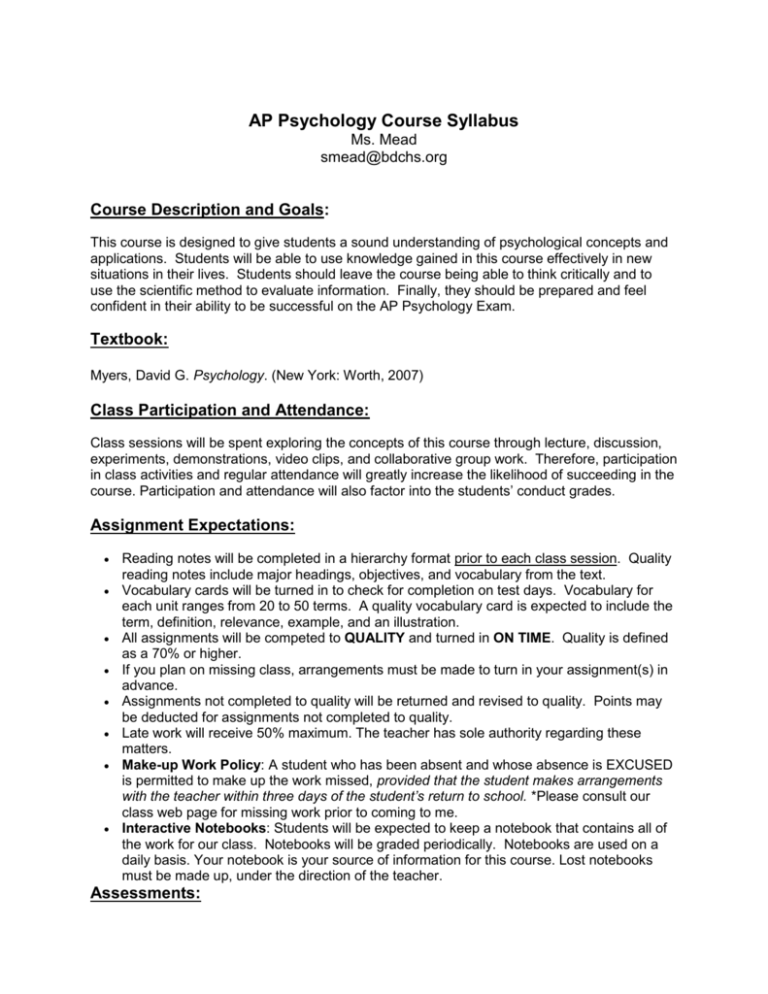
AP Psychology Course Syllabus Ms. Mead smead@bdchs.org Course Description and Goals: This course is designed to give students a sound understanding of psychological concepts and applications. Students will be able to use knowledge gained in this course effectively in new situations in their lives. Students should leave the course being able to think critically and to use the scientific method to evaluate information. Finally, they should be prepared and feel confident in their ability to be successful on the AP Psychology Exam. Textbook: Myers, David G. Psychology. (New York: Worth, 2007) Class Participation and Attendance: Class sessions will be spent exploring the concepts of this course through lecture, discussion, experiments, demonstrations, video clips, and collaborative group work. Therefore, participation in class activities and regular attendance will greatly increase the likelihood of succeeding in the course. Participation and attendance will also factor into the students’ conduct grades. Assignment Expectations: Reading notes will be completed in a hierarchy format prior to each class session. Quality reading notes include major headings, objectives, and vocabulary from the text. Vocabulary cards will be turned in to check for completion on test days. Vocabulary for each unit ranges from 20 to 50 terms. A quality vocabulary card is expected to include the term, definition, relevance, example, and an illustration. All assignments will be competed to QUALITY and turned in ON TIME. Quality is defined as a 70% or higher. If you plan on missing class, arrangements must be made to turn in your assignment(s) in advance. Assignments not completed to quality will be returned and revised to quality. Points may be deducted for assignments not completed to quality. Late work will receive 50% maximum. The teacher has sole authority regarding these matters. Make-up Work Policy: A student who has been absent and whose absence is EXCUSED is permitted to make up the work missed, provided that the student makes arrangements with the teacher within three days of the student’s return to school. *Please consult our class web page for missing work prior to coming to me. Interactive Notebooks: Students will be expected to keep a notebook that contains all of the work for our class. Notebooks will be graded periodically. Notebooks are used on a daily basis. Your notebook is your source of information for this course. Lost notebooks must be made up, under the direction of the teacher. Assessments: A variety of assessments allow me to determine whether students understand the concepts well enough to apply them in new situations. Review assignments, quizzes, and tests inform me of each student’s progress toward mastery of the content and that student’s ability to do well on the AP Exam. Tests occur at the end of each unit. Students are provided with in-class review sessions. Tests are given to replicate the AP exam environment. Students have 35 minutes to answer 50 multiple- choice questions and 25 minutes to answer one of two free response questions. Quizzes occur at the end of each chapter to ensure that students are keeping up with readings. Course Sequence: I. The Story of Psychology A. Historical Schools: Structuralism and Functionalism B. Methods of Inquiry: Introspection and Empiricism C. Contemporary Perspectives: Neuroscience, Evolutionary, Psychodynamic, Behavioral, Cognitive, Humanistic, Socio-cultural D. Levels of Analysis: The biopsychosocial approach II. Learning and Memory A. B. C. D. E. Classical Conditioning: Pavlov, Watson, applications, and criticisms Operant Conditioning: Skinner, Thorndike, principles of reinforcement Observational Learning: Bandura, prosocial behavior Information Processing: Encoding, storage, and retrieval Forgetting and Memory Construction: Ebbinghaus and Loftus III. Sensation and Perception A. Basic Principles: Top-down processing, bottom-up processing, thresholds, sensory adaptation, Weber’s law B. Vision: The Eye, Young-Hemholtz trichromatic theory, opponent-process theory C. Audition: The Ear, place theory, frequency theory D. Touch, Taste, and Smell: sensory interaction, Ramachandran’s phantom limb and parallel processing studies IV. Social Psychology A. Attitudes and Behavior: Fundamental attribution error, self serving bias, cognitive dissonance B. Group Influences: Asch’s conformity experiment, Milgram’s obedience study, Zimbardo prison experiment C. Prejudice and Aggression: stereotypes, just-world phenomenon, frustration aggression principle D. Attraction and Altruism: Sternberg’s triangular theory of love, social-responsibility norms V. Neuroscience and The Nature-Nurture Debate A. B. C. D. Neural Communication: Anatomy of a neuron, action potentials, neurotransmitters The Nervous System: Peripheral and Central nervous systems, neural networks The Endocrine System: Hormones, the role of the hypothalamus The Brain: Neuroanatomy, Neuroimaging, Specialized structures, hemispheric differences E. Behavior Genetics: genes, twin studies, adoption studies, heritability, gene-environment interaction F. Evolutionary Psychology: Natural Selection G. Parent, Peer, and Cultural Influences on Behavior VI. Cognition A. B. C. D. E. Thinking: Concepts, Problem-solving, Judgment and Decision-Making Language Development: B.F. Skinner vs. Noam Chomsky Linguistic Determinism: Whorf’s hypothesis Animal Thinking and Language: The case of the apes Intelligence: general intelligence, Sternberg’s triarchic theory, Gardner’s multiple intelligences F. Intelligence Testing: Stanford-Binet, Wechsler Adult Intelligence Scale, principles of test construction G. The Dynamics of Intelligence: giftedness, savant syndrome, genetic and environmental influences VII. Abnormal Psychology A. Defining Psychological Disorders: Classification and Labeling of Psychological Disorders, DSM-IV-TR, Keyes’s “Mental Health as Flourishing”, the biopsychosocial approach, the medical model B. Categories of Disorders: Anxiety disorders, Mood disorders, Schizophrenia, Personality disorders, Dissociative disorders C. The Psychotherapies: Psychoanalysis, Humanistic Therapies, Behavior Therapies, Cognitive Therapies, Gestalt Therapy, Group and Family Therapy, Biomedical Therapies D. Evaluating Psychotherapies: Measuring Effectiveness, Alternative Therapies, Regression toward the mean, commonalities among therapies E. Prevention of Psychological Disorders: Mental Health Awareness Project VIII. Research Methods: Thinking Critically With Psychological Science A. Descriptive Methods: The Case Study, The Survey, Naturalistic Observation B. Correlational Research and Experimentation: Correlation vs. Causation, The Scientific Method, Cause and Effect C. Statistical Reasoning: Measures of Central Tendency, Measures of Variation, Statistical Significance D. Ethics in Research IX. Motivation and Emotion A. B. C. D. E. F. G. X. Perspectives on Motivation: Instincts, Drive-reduction theory, Hierarchy of needs Hunger and Eating Disorders Sexual Motivation The Need to Belong Industrial-Organizational Psychology Theories of Emotion: James-Lange, Cannon-Bard, Schacter-Singer Expression and Experience of Emotion: Fear, Anger, and Happiness Developmental Psychology A. Infancy, Childhood, Adolescence, and Adulthood B. Major Theories: Piaget’s Stages of Cognitive Development, Attachment theories, Kohlberg’s Moral Reasoning, Erik Erikson’s Psychosocial Stages of Development C. Death and Dying: Stages of Grief, Cultural Perspectives on Death XI. Personality A. B. C. D. E. Psychoanalytic Perspective and Unconscious Processes: Freud, Adler, and Jung Humanistic Perspective and Self-Actualization: Maslow and Rogers Trait Perspective: The Big Five, factor analysis, Myer’s-Briggs, and MMPI The Social-Cognitive Perspective Self-Esteem XII. States of Consciousness A. Sleep and Dreams: stages of sleep, purposes of sleep and dreams B. Hypnosis C. Drugs and Consciousness XIII. Stress and Health A. Stress and Illness B. Stress Appraisal C. Managing Stress: Exercise, Biofeedback, Relaxation, and Meditation
